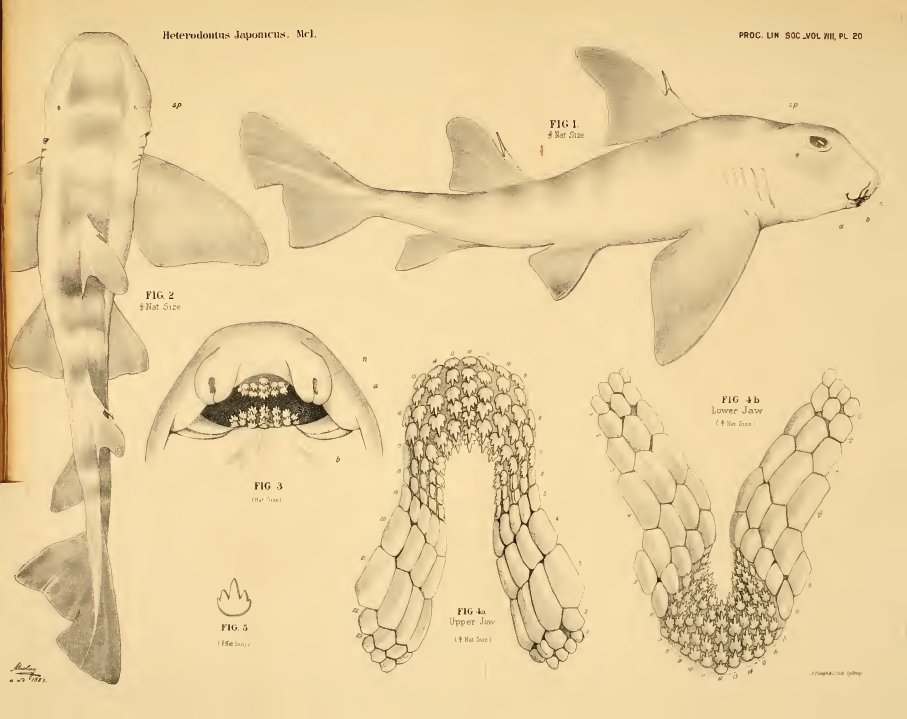Heterodontus japonicus
Maclay & Macleay, 1884
Japanese bullhead shark
Classification: Elasmobranchii Heterodontiformes Heterodontidae
Reference of the original description
Plagiostomata of the Pacific. Part II. Proceedings of the Linnean Society of New South Wales, ser. 1, 8(4), 426–431
Plagiostomata of the Pacific. Part II. Proceedings of the Linnean Society of New South Wales, ser. 1, 8(4), 426–431
Image of the original description

Heterodontus japonicus Maclay & Macleay, 1884

Heterodontus japonicus Maclay & Macleay, 1884
Synonyms / new combinations and misspellings
Centracion japonicum, Centracion japonicus, Cestracion japonicus, Cestracion philippi japonicus
Centracion japonicum, Centracion japonicus, Cestracion japonicus, Cestracion philippi japonicus
Types
Heterodontus japonicus
Holotype: AMS: B.68;
Cestracion philippi japonicus
XXXX: No types known;
Heterodontus japonicus
Holotype: AMS: B.68;
Cestracion philippi japonicus
XXXX: No types known;
Description :
Citation: Heterodontus japonicus Maclay & Macleay, 1884: In: Database of modern sharks, rays and chimaeras, www.shark-references.com, World Wide Web electronic publication, Version 12/2025
Please send your images of "Heterodontus japonicus" to info@shark-references.com

Heterodontus japonicus Maclay & Macleay, 1884 © FAO, www.fish-base.org

Heterodontus japonicus Maclay & Macleay, 1884 © FAO, www.fish-base.org
Common names
 Japanischer Hornhai,
Japanischer Hornhai,  Dormilón japonés,
Dormilón japonés,  Requin dormeur nekozame,
Requin dormeur nekozame,  Bull-head shark,
Bull-head shark,  Japanease bullhead shark,
Japanease bullhead shark,  Japanese bullhead shark,
Japanese bullhead shark,  Port Jackson shark
Port Jackson shark
 Japanischer Hornhai,
Japanischer Hornhai,  Dormilón japonés,
Dormilón japonés,  Requin dormeur nekozame,
Requin dormeur nekozame,  Bull-head shark,
Bull-head shark,  Japanease bullhead shark,
Japanease bullhead shark,  Japanese bullhead shark,
Japanese bullhead shark,  Port Jackson shark
Port Jackson shark
Distribution
Northwest Pacific: off Japan, Korean Republic, northern China including Taiwan Island. Source: www.gbif.org
Northwest Pacific: off Japan, Korean Republic, northern China including Taiwan Island. Source: www.gbif.org
Human uses
fisheries: minor commercial; price category: not marketed/unknown; price reliability:
fisheries: minor commercial; price category: not marketed/unknown; price reliability:
Biology
Oviparous. Eggs are laid in rocks or in kelp at depths of about 8 or 9 m and are present from March through September. Eggs are more abundant, however, in March and April. Eggs are hatched in about a year; size at hatching is about 18 cm. There may be a `nest"quot; for several females laying eggs but this is not a true nest. A female lays two eggs at a time, for 6 to 12 spawnings. Found on the continental shelf, more commonly on rocky and kelp-covered bottom. Feeds on crustaceans, molluscs (including top shells), small fishes and sea urchins[17641]
Oviparous. Eggs are laid in rocks or in kelp at depths of about 8 or 9 m and are present from March through September. Eggs are more abundant, however, in March and April. Eggs are hatched in about a year; size at hatching is about 18 cm. There may be a `nest"quot; for several females laying eggs but this is not a true nest. A female lays two eggs at a time, for 6 to 12 spawnings. Found on the continental shelf, more commonly on rocky and kelp-covered bottom. Feeds on crustaceans, molluscs (including top shells), small fishes and sea urchins[17641]
Remarks
shark-references Species-ID=2775;
shark-references Species-ID=2775;
Parasites (arranged by Jürgen Pollerspöck)
Cestoda
Copepoda
Isopoda
Hirudinea
Cestoda
Copepoda
- Dissonus nudiventris Kabata, 1965 [16540]
Isopoda
- Thaumastognathia bicorniger Ota, Kurashima & Horie, 2022 [30445]
Hirudinea
















